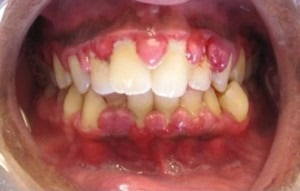Part 3: Micro-organisms in the Mouth
Please see the other parts of the article; once they are completed the links will be active:
Part 1: anatomy of the human microbiome
Part 2: micro-organisms on the skin
Part 4: micro-organisms in the gut
Part 5: implications for modern medicine

Your mouth harbors a diverse, abundant, and extremely complex community of microscopic organisms. These bacteria form biofilms on the soft and hard tissues of your mouth, tongue, cheeks, tonsils and upper throat; this adhesion allows them to stick on the surface. Essentially, these bacteria form a sticky or slimy film that builds-up over time. These biofilms are known as plaque and their build-up is what causes dental diseases, such as periodontal disease (which research suggests is always preceded by gingivitis) and dental caries (cavities) as well as other diseases if they are able to enter the bloodstream.
Plaque (oral bacteria) build-up in the mouth is normal; its control is what prevents tooth decay and gum disease. These bacteria have evolved mechanisms to evade and modify the host; the host in turn has a defense system that monitors bacterial colonization and prevents invasion. This equilibrium between the host and bacteria is dynamic and varies greatly from person to person.
When we are born, our mouths do not contain any bacteria yet; during the course of development bacteria accumulate to allow for the dynamic equilibrium that I previously mentioned. Some major landmarks are the growth of teeth, and full maturation at about the time of puberty. Some names of the bacteria are streptococci, lactobacilli (common in probiotic supplements), staphylococci, corynebacteria and some other anaerobic bacteria (non-oxygen consuming); streptococcus salivarius (think saliva) is very interesting because it colonizes the mouth and upper respiratory tract just after birth and is an opportunistic pathogen, meaning it rarely finds its way into the bloodstream to cause harm (usually a decrease in white blood cells) and is mostly beneficial to digestion.
You can probably see why disrupting the bacterial growth in your mouth is a daily activity; plaque build-up can cause unhealthy amounts of bacteria in the mouth, especially with large amounts of sugar consumption. Flossing should be a daily activity as well because it performs the same functions as brushing in that it reaches the places that your toothbrush doesn’t in between the teeth and along the gum-line. However, I think that brushing three times a day is probably somewhat of a myth promoted by the dental industries; once a day is probably all you need, unless you are eating food with high bacterial content or sugar content regularly, or food with high acidity (which is probably the case if you are vegan, vegetarian, or just eat lots of fruit).
The WHO (World Health Organization) says that nearly all adults have dental carries during their life. It’s estimated that currently 36% of the population has carries and that number is steadily increasing as the world becomes more developed because of simple sugar consumption. Remember that bacteria love sugar!
Interestingly, kissing with full tongue contact is evidenced to provide exposure to the oral micro-organisms of the other and could be an indicator for the hosts about the bacterial health of their partner. This might indicate mating compatibility, amongst other things. Some of the bacteria that are shared on the tongue’s surface have long-term colonization effects, meaning that kissing might lead to increased diversity in tongue bacteria. Cool, right? So kissing might be some kind of a test for bacterial compatibility in your potential mate during the courting process.
This article is probably the shortest in the ecosystem of the human body series. I hope you are enjoying it! Part 4 is all about gut bacteria, so check back soon to learn all about gut health.
Please leave any questions or feedback in the comments, thanks for reading.
Sources:
- http://www.sciencedirect.com/science/article/pii/S0095454313001073
- http://onlinelibrary.wiley.com/doi/10.1046/j.0906-6713.2002.003421.x/abstract;jsessionid=3363B7658E220D69B2BDB670F2CE5436.f04t02
- http://my.americanheart.org/professional/General/The-Complexity-of-the-Periodontal-Disease_UCM_439052_Article.jsp#mainContent
- http://www.homd.org/
- http://jb.asm.org/content/192/19/5002.full
- http://www.microbiomejournal.com/content/2/1/41

